Ingest pipeline 允许文档在被索引之前对数据进行预处理,将数据加工处理成我们需要的格式。例如,可以使用 ingest pipeline添加或者删除字段,转换类型,解析内容等等。Pipeline 由一组处理器 Processor 构成,每个处理器依次运行,对传入的文档进行特定的更改。Ingest pipeline 和 Logstash 中的 filter 作用相似,并且更加轻量和易于调试。
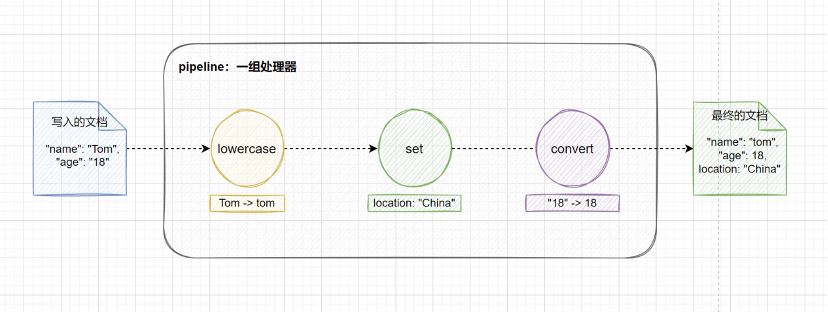
要使用 ingest pipeline,集群中必须至少有一个具有 ingest 角色的节点。对于大量摄取负载,建议设置专用的 ingest 节点,要创建专用的 ingest 节点,请设置:
node.roles: [ ingest ]接下来介绍一下 ingest pipeline 的创建与使用,如下所示,使用 ingest API 创建一个名为 my-pipeline 的 ingest pipeline,在 processors 参数中指定了两个处理器,set 处理器为文档添加一个新的字段 location,设置值为 China;lowercase 处理器将 name 字段的所有字母转换为小写。
PUT _ingest/pipeline/my-pipeline
{
"description": "My first Ingest Pipeline",
"processors": [
{
"set": {
"description": "Add a new field",
"field": "location",
"value": "China"
}
},
{
"lowercase": {
"description": "Lowercase name",
"field": "name"
}
}
]
}然后往索引 my-index 中写入一条数据,通过 pipeline 参数指定使用刚刚创建的 my-pipeline。
PUT my-index/_doc/1?pipeline=my-pipeline
{
"name": "Tom",
"age": 18
}查看 id 为 1 的文档,可以看到 name 字段由 Tom 转换为 tom,并且新增了 location 字段,说明 my-pipeline 管道成功处理了摄入的数据。
GET my-index/_doc/1
# 返回结果
{
"_index" : "my-index",
"_type" : "_doc",
"_id" : "1",
"_version" : 1,
"_seq_no" : 0,
"_primary_term" : 1,
"found" : true,
"_source" : {
"name" : "tom",
"location" : "China",
"age" : 18
}
}为了让开发者更好地了解和使用 pipeline 中的处理器,Elasticsearch 提供了 simulate API 接口,方便我们对 pipeline 进行测试。如下所示,我们对 1.1 创建和使用 Ingest Pipeline 章节中创建的 my-pipeline 进行测试,在 docs 列表中我们可以填写多个原始文档。
POST _ingest/pipeline/my-pipeline/_simulate
{
"docs": [
{
"_source": {
"name": "Tom",
"age": 18
}
}
]
}返回结果如下,可以看到模拟的结果和实际创建的文档一致,只不过 simulate API 并不会真正地创建这个文档。
{
"docs" : [
{
"doc" : {
"_index" : "_index",
"_type" : "_doc",
"_id" : "_id",
"_source" : {
"name" : "tom",
"location" : "China",
"age" : 18
},
"_ingest" : {
"timestamp" : "2022-03-03T14:04:15.941884826Z"
}
}
}
]
}除了在请求路径中指定 pipeline,我们还可以在请求体中定义 pipeline 进行模拟,这样就不用预先创建好 pipeline,而是等到测试成功后再去创建 pipeline。
POST _ingest/pipeline/_simulate
{
"pipeline": {
"processors": [
{
"set": {
"description": "Add a new field",
"field": "location",
"value": "China"
}
},
{
"lowercase": {
"description": "Lowercase name",
"field": "name"
}
}
]
},
"docs": [
{
"_source": {
"name": "Tom",
"age": 18
}
}
]
}当我们使用 pipeline 处理一个文档的时候,有时并不是所有的文档都很规范,这个时候可能就会出现文档不能被正确解析或者发生异常的情况,此时 Elasticsearch 会返回给客户端一个错误的信息,表明文档不能被正确地处理。pipeline 中的处理器(processor)按照顺序依次执行,默认情况下,当处理器发生错误或者异常时,将会停止后续的处理。
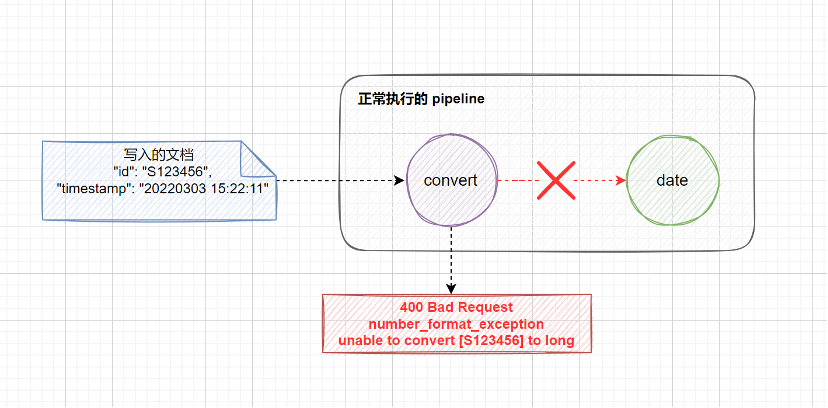
在 ingest pipeline 中,异常处理可以分为 3 种情况:
ignore_failure: true,当该处理器发生异常时,允许忽略异常,继续执行后续的处理器。on_failure 参数定义发生异常时执行的处理器列表,该参数可以在 processor 级别中定义,也可以在 pipeline 级别中定义。下面将会分别对上述 3 种情况进行演示,首先模拟 2 个异常:
执行以下 pipeline 测试语句,在请求路径中加上 verbose 可以看到每个处理器的执行情况。
POST _ingest/pipeline/_simulate?verbose
{
"pipeline": {
"processors": [
{
"convert": {
"field": "id",
"type": "long"
}
},
{
"date": {
"field": "timestamp", // 解析的字段
"formats": [
"yyyy-MM-dd HH:mm:ss" // 解析的格式
],
"output_format": "yyyy/MM/dd", // 输出的格式
"target_field": "date" // 输出的字段
}
}
]
},
"docs": [
{
"_source": {
"id": "S123456",
"timestamp": "20220303 15:22:11",
"message": "User login successfully"
}
}
]
}返回结果如下,尽管我们人为制造了 2 个异常,但是只看到了 convert 处理器的异常报错,这是因为当处理器发生错误或者异常时,将会停止后续的处理,直接向客户端返回错误信息。
{
"docs" : [
{
"processor_results" : [
{
"processor_type" : "convert",
"status" : "error",
"error" : {
"root_cause" : [
{
"type" : "illegal_argument_exception",
"reason" : "unable to convert [S123456] to long"
}
],
"type" : "illegal_argument_exception",
"reason" : "unable to convert [S123456] to long",
"caused_by" : {
"type" : "number_format_exception",
"reason" : "For input string: \"S123456\""
}
}
}
]
}
]
}在处理器中设置 ignore_failure 参数为 true,当该处理器发生异常时,允许忽略异常,继续执行后续的处理器。
POST _ingest/pipeline/_simulate?verbose
{
"pipeline": {
"processors": [
{
"convert": {
"field": "id",
"type": "long",
"ignore_failure": true // 忽略异常
}
},
{
"date": {
"field": "timestamp",
"formats": [
"yyyy-MM-dd HH:mm:ss"
],
"output_format": "yyyy/MM/dd",
"target_field": "date"
}
}
]
},
"docs": [
{
"_source": {
"id": "S123456",
"timestamp": "2022/03/03 15:22:11",
"message": "User login successfully"
}
}
]
}这次在返回结果中可以看到有 2 个异常信息,其中 convert 处理器的 status 的值为 error_ignored,表示该异常被忽略了,在 doc 中可以看到该处理器处理完毕后的结果,可以看到 id 字段的内容保留不变。接着 pipeline 继续往后执行,当执行到 date 处理器时,再次发生异常,由于 date 处理器中未对异常进行处理,此时向客户端返回异常信息。
{
"docs" : [
{
"processor_results" : [
{
"processor_type" : "convert",
"status" : "error_ignored", // 第 1 个异常,忽略异常
"ignored_error" : {
"error" : {
"root_cause" : [
{
"type" : "illegal_argument_exception",
"reason" : "unable to convert [S123456] to long"
}
],
"type" : "illegal_argument_exception",
"reason" : "unable to convert [S123456] to long",
"caused_by" : {
"type" : "number_format_exception",
"reason" : "For input string: \"S123456\""
}
}
},
"doc" : {
"_index" : "_index",
"_type" : "_doc",
"_id" : "_id",
"_source" : {
"id" : "S123456", // 跳过 convert 处理器对 id 字段的处理
"message" : "User login successfully",
"timestamp" : "2022/03/03 15:22:11"
},
"_ingest" : {
"pipeline" : "_simulate_pipeline",
"timestamp" : "2022-03-04T02:48:13.562353005Z"
}
}
},
{
"processor_type" : "date",
"status" : "error", // 第 2 个异常
"error" : {
"root_cause" : [
{
"type" : "illegal_argument_exception",
"reason" : "unable to parse date [2022/03/03 15:22:11]"
}
],
"type" : "illegal_argument_exception",
"reason" : "unable to parse date [2022/03/03 15:22:11]",
"caused_by" : {
"type" : "illegal_argument_exception",
"reason" : "failed to parse date field [2022/03/03 15:22:11] with format [yyyy-MM-dd HH:mm:ss]",
"caused_by" : {
"type" : "date_time_parse_exception",
"reason" : "Text '2022/03/03 15:22:11' could not be parsed at index 4"
}
}
}
}
]
}
]
}使用 on_failure 参数可以定义发生异常时执行的处理器列表,该参数允许在 processor 和 pipeline 级别中定义。在 pipeline 级别定义时,on_failure 捕获整个 pipeline 发生的任何异常,当产生异常时直接执行 on_failure 中定义的处理器列表,不会再执行后续的处理器。
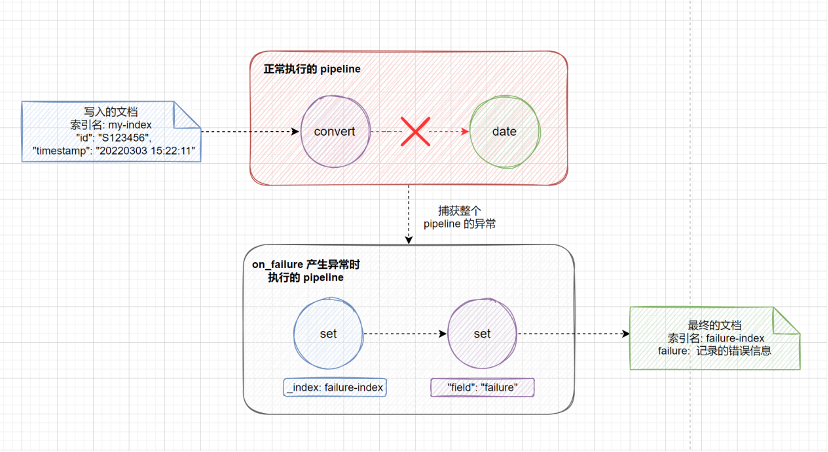
在 processor 级别定义时,on_failure 参数可以针对单个处理器进行异常处理,会继续执行后续的处理器。
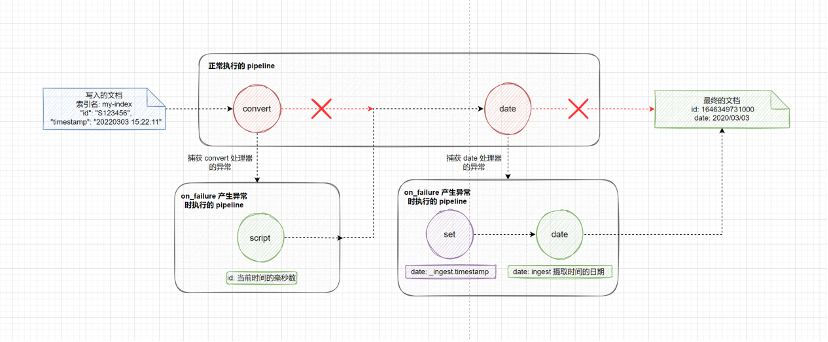
on_failure 参数可以同时在 pipeline 和 processor 中定义,这两者并不冲突,比较推荐的做法是,针对某些处理器设置 processor 级别的 on_failure 处理规则,另外设置 pipeline 级别的 on_failure 处理规则作为一条兜底的规则,当 processor 级别的 on_failure 处理规则也发生异常时或者没有设置异常处理的处理器发生异常时,就可以应用这条兜底的规则,这样做的好处就是可以尽可能地保证我们的 ingest pipeline 的健壮性。
如下所示,在 pipeline 级别设置了 on_failure 的处理规则,注意这里的 on_failure 参数和 processors 参数是处于同一层级的。当发生异常时, on_failure 会执行里面的 set 处理器,将索引名改为 failure-index,该索引专门用于记录 pipeline 处理异常的文档。之后我们就可以在 failure-index 索引中去查看哪些文档在预处理时发生了异常,方便后续实施相应的补救措施。
PUT _ingest/pipeline/failure-test-pipeline
{
"processors": [
{
"convert": {
"field": "id",
"type": "long"
}
},
{
"date": {
"field": "timestamp",
"formats": [
"yyyy-MM-dd HH:mm:ss"
],
"output_format": "yyyy/MM/dd",
"target_field": "date"
}
}
],
"on_failure": [ // 发生异常时执行的处理器列表
{
"set": {
"field": "_index", // 通过 _index 元数据字段,可以改变写入的索引
"value": "failure-index"
}
}
]
}然后往 my-index 索引中插入一条有错误的文档,将文档 _id 设置为 1。从返回结果来看,并没有异常报错,文档成功写入了。但是仔细观察可以发现,文档并没有写入 my-index 索引,而是写入了我们记录异常的索引 failure-index。
PUT my-index/_doc/1?pipeline=failure-test-pipeline
{
"id": "S123456",
"timestamp": "2022/03/03 15:22:11",
"message": "User login successfully"
}
# 返回结果
{
"_index" : "failure-index", // 写入了记录异常的索引
"_type" : "_doc",
"_id" : "1",
"_version" : 1,
"result" : "created",
"_shards" : {
"total" : 2,
"successful" : 1,
"failed" : 0
},
"_seq_no" : 0,
"_primary_term" : 1
}查询 my-index 文档,确实没有找到 _id 为 1 的这条文档。
GET my-index/_doc/1
# 返回结果
{
"error" : {
"root_cause" : [
{
"type" : "index_not_found_exception",
"reason" : "no such index [my-index]",
"resource.type" : "index_expression",
"resource.id" : "my-index",
"index_uuid" : "_na_",
"index" : "my-index"
}
],
"type" : "index_not_found_exception",
"reason" : "no such index [my-index]",
"resource.type" : "index_expression",
"resource.id" : "my-index",
"index_uuid" : "_na_",
"index" : "my-index"
},
"status" : 404
}查询 failure-index 索引可以找到这条处理异常的文档。
GET failure-index/_doc/1
# 返回结果
{
"_index" : "failure-index",
"_type" : "_doc",
"_id" : "1",
"_version" : 1,
"_seq_no" : 0,
"_primary_term" : 1,
"found" : true,
"_source" : {
"id" : "S123456",
"message" : "User login successfully",
"timestamp" : "2022/03/03 15:22:11"
}
}对于我们来说,目前 failure-index 索引记录的信息十分有限,根据以上内容我们无法知道是哪个处理器在执行时产生了异常。在 on_failure 中提供了以下 4 个元数据字段方便我们进行故障定位:
on_failure_pipeline:产生异常的 pipeline 类型的处理器中引用的 pipeline。ingest pipeline 中有一个 pipeline 类型的处理器,该处理器也可以指定使用其他的 pipeline,这里注意区分 pipeline 类型的处理器和 pipeline 管道。on_failure_message:报错的内容。on_failure_processor_type:产生异常的处理器的标签,标签可以在处理器中通过 tag 参数指定。当 pipeline 中使用了多个相同类型的处理器时,根据指定的标签可以方便我们进行区分。on_failure_processor_tag:产生异常的处理器的类型。如下所示,我们在 on_failure 参数新增了一个 set 处理器,将错误信息写入 failure-index 的 failure 字段中。
PUT _ingest/pipeline/failure-test-pipeline
{
"processors": [
{
"convert": {
"tag": "my-index-convert", // 设置处理器的标签,方便定位问题
"field": "id",
"type": "long"
}
},
{
"date": {
"tag": "my-index-date", // 设置处理器的标签,方便定位问题
"field": "timestamp",
"formats": [
"yyyy-MM-dd HH:mm:ss"
],
"output_format": "yyyy/MM/dd",
"target_field": "date"
}
}
],
"on_failure": [
{
"set": {
"field": "_index",
"value": "failure-index"
}
},
{
"set": {
"field": "failure",
"value": {
"on_failure_pipeline": "{{ _ingest.on_failure_pipeline }}",
"on_failure_message": "{{_ingest.on_failure_message}}",
"on_failure_processor_type": "{{_ingest.on_failure_processor_type}}",
"on_failure_processor_tag": "{{ _ingest.on_failure_processor_tag }}"
}
}
}
]
}然后往 my-index 索引中插入一条有错误的文档,将文档 _id 设置为 2。
PUT my-index/_doc/2?pipeline=failure-test-pipeline
{
"id": "S123456",
"timestamp": "2022/03/03 15:22:11",
"message": "User login successfully"
}查看 failure-index 索引记录的错误信息,可以得知打了 my-index-convert 标签的 convert 类型的处理器在处理 S123456 字符串时引发了异常。细心的同学可能会注意到, 在返回结果中 on_failure_pipeline 的内容为空,这是由于异常并不是由 pipeline 类型的处理器产生的,所以这里的结果是空值。如果只是想获取客户端直接调用的 ingest pipeline,那么可以通过 _ingest.pipeline 来获取。
{
"_index" : "failure-index",
"_type" : "_doc",
"_id" : "2",
"_version" : 1,
"_seq_no" : 1,
"_primary_term" : 1,
"found" : true,
"_source" : {
"failure" : {
"on_failure_pipeline" : "", // 产生异常的 pipeline 类型的处理器中引用的 pipeline
"on_failure_message" : "For input string: \\\"S123456\\\"", // 报错的内容
"on_failure_processor_tag" : "my-index-convert", // 产生异常的处理器的标签
"on_failure_processor_type" : "convert" // 产生异常的处理器的类型
},
"id" : "S123456",
"message" : "User login successfully",
"timestamp" : "2022/03/03 15:22:11"
}
}上面的示例介绍了 on_failure 参数在 pipeline 级别的处理,现在介绍下 on_failure 参数如何在 processor 级别进行处理。如下所示,在 convert 和 date 处理器中分别通过 on_failure 参数设置了发生异常时执行的处理器列表:当convert 进行类型转换发生异常时,将当前时间的毫秒数设置 id 字段的值;当 date 处理器解析时间发生异常时,使用 ingest 摄取时间的日期戳作为 date 字段的值。
PUT _ingest/pipeline/failure-test-pipeline
{
"processors": [
{
"convert": {
"field": "id",
"type": "long",
"on_failure": [ // 发生异常时将当前时间的毫秒数设置 id 字段的值
{
"script": {
"source": """
long timeNow = Calendar.getInstance().getTimeInMillis();
ctx.id = timeNow;
"""
}
}
]
}
},
{
"date": {
"field": "timestamp",
"formats": [
"yyyy-MM-dd HH:mm:ss"
],
"output_format": "yyyy/MM/dd",
"target_field": "date",
"on_failure": [ // 发生异常时使用 ingest 摄取时间的日期戳作为 date 字段的值
{
"set": {
"field": "date",
"value": "{{_ingest.timestamp}}"
}
},
{
"date": {
"field": "date",
"formats": [
"yyyy-MM-dd'T'HH:mm:ss.SSSZ"
],
"output_format": "yyyy/MM/dd",
"target_field": "date"
}
}
]
}
}
]
}然后往 my-index 索引中插入一条有错误的文档,将文档 _id 设置为 3。文档正常写入 my-index 中,没有返回报错信息。
PUT my-index/_doc/3?pipeline=failure-test-pipeline
{
"id": "S123456",
"timestamp": "2022/03/03 15:22:11",
"message": "User login successfully"
}
# 返回结果
{
"_index" : "my-index",
"_type" : "_doc",
"_id" : "3",
"_version" : 1,
"result" : "created",
"_shards" : {
"total" : 2,
"successful" : 1,
"failed" : 0
},
"_seq_no" : 0,
"_primary_term" : 1
}获取 my-index 索引中 _id 为 3 的文档,可以看到 id 字段的值并不是传入的原始文档中的 S123456,而是当前时间对应的毫秒值;date 字段的值被设置为了 ingest 摄取时间的日期。
GET my-index/_doc/3
# 返回结果
{
"_index" : "my-index",
"_type" : "_doc",
"_id" : "3",
"_version" : 1,
"_seq_no" : 0,
"_primary_term" : 1,
"found" : true,
"_source" : {
"date" : "2022/03/03",
"id" : 1646349731000,
"message" : "User login successfully",
"timestamp" : "2022/03/03 15:22:11"
}
}和 ignore_failure, on_failure 两种处理异常的方式不同,使用 fail 处理器可以基于某些条件主动抛出异常,当你想要主动让 pipeline 失败并且返回特定的报错信息给请求者时,可以使用这种方式。如下所示,当 tags 字段中不包含 production 时,fail 处理器会主动抛出异常,在 message 参数中可以自定义相应的报错信息。
POST _ingest/pipeline/_simulate
{
"pipeline": {
"processors": [
{
"fail": {
"if": "ctx.tags.contains('production') != true",
"message": "The production tag is not present, found tags: {{{tags}}}"
}
}
]
},
"docs": [
{
"_source": {
"tags": ["development"]
}
}
]
}
# 返回结果
{
"docs" : [
{
"error" : {
"root_cause" : [
{
"type" : "fail_processor_exception",
// 自定义的报错信息
"reason" : "The production tag is not present, found tags: {0=development}"
}
],
"type" : "fail_processor_exception",
"reason" : "The production tag is not present, found tags: {0=development}"
}
}
]
}每种类型的处理器中都支持 if 参数判断执行处理器的条件,在 if 参数中使用 painless脚本进行逻辑判断,当 if 的判断结果为 true 时,相应的处理器才会执行。如下所示,创建了 if-test-pipeline,我们只想日志级别是 error 的消息,当 level 字段的值是 notice 时,丢弃该文档。
PUT _ingest/pipeline/if-test-pipeline
{
"processors": [
{
"drop": {
"description": "Drop documents with level of notice",
"if": "ctx.level == 'notice'"
}
}
]
}然后往 log-index 索引中写入两条文档,指定使用 if-test-pipeline,其中一条文档的 level 值等于 notice,另一条的 level 值等于 error。
POST log-index/_doc?pipeline=if-test-pipeline
{
"level": "notice",
"message": "this is a notice log"
}
POST log-index/_doc?pipeline=if-test-pipeline
{
"level": "error",
"message": "this is a error log"
}查询 log-index 索引,只返回了 1 条文档,level 等于 notice 的文档被丢弃了。
GET log-index/_search
# 返回结果
{
"took" : 1,
"timed_out" : false,
"_shards" : {
"total" : 1,
"successful" : 1,
"skipped" : 0,
"failed" : 0
},
"hits" : {
"total" : {
"value" : 1,
"relation" : "eq"
},
"max_score" : 1.0,
"hits" : [
{
"_index" : "log-index",
"_type" : "_doc",
"_id" : "fV9ET38BKRZVqZj9X8yC",
"_score" : 1.0,
"_source" : {
"level" : "error",
"message" : "this is a error log"
}
}
]
}
}接下来介绍一种高级的用法,将一个 pipeline 作为多个不同的索引或者数据流默认的 pipeline,在这个 pipeline 中创建多个 pipeline 类型的处理器,每个处理器根据传入的文档选择后台真正要执行的 pipeline。这样做的好处就是,如果要更改后台使用的 pipeline,只需要修改默认的 pipeline 中引用的 pipeline 即可,客户端的代码或者索引中的设置无需修改,可以做到业务无感知的切换。如下所示,先创建两个 pipeline,其中 httpd_pipeline 用于处理 http 相关的日志,syslog_pipeline 用于处理 syslog 相关的日志。
PUT _ingest/pipeline/httpd_pipeline
{
"processors": [
{
"set": {
"field": "message",
"value": "this is a apache_httpd log"
}
}
]
}
PUT _ingest/pipeline/syslog_pipeline
{
"processors": [
{
"set": {
"field": "message",
"value": "this is a syslog log"
}
}
]
}接着创建一个 default_pipeline,使用 if 参数进行判断,当 service 字段的值等于 apache_httpd 时,执行 httpd_pipeline,当 service 字段的值等于 syslog 时,执行 syslog_pipeline。
PUT _ingest/pipeline/default_pipeline
{
"processors": [
{
"pipeline": {
"description": "If 'service' is 'apache_httpd', use 'httpd_pipeline'",
"if": "ctx.service == 'apache_httpd'",
"name": "httpd_pipeline"
}
},
{
"pipeline": {
"description": "If 'service' is 'syslog', use 'syslog_pipeline'",
"if": "ctx.service == 'syslog'",
"name": "syslog_pipeline"
}
}
]
}使用 simulate API 进行验证,可以看到由于传入的文档的 service 字段的值是 syslog,因此这条文档被交给 syslog_pipeline 进行处理。
POST _ingest/pipeline/default_pipeline/_simulate
{
"docs": [
{
"_source": {
"service": "syslog"
}
}
]
}
# 返回结果
{
"docs" : [
{
"doc" : {
"_index" : "_index",
"_type" : "_doc",
"_id" : "_id",
"_source" : {
"message" : "this is a syslog log", // syslog_pipeline 添加的内容
"service" : "syslog"
},
"_ingest" : {
"timestamp" : "2022-03-04T07:18:53.531846541Z"
}
}
}
]
}下表列出了 Elasticsearch 所有 processor 处理器的类型,并且根据各个处理器的用途作了相应的分类。下面的小节中仅会演示说明一些常用的处理器,未介绍到的部分读者可以自行查阅官方文档。
类别 | 处理器 | 作用 |
|---|---|---|
数组处理 | append | 添加元素 |
数组处理 | sort | 对数组中的元素进行排序 |
数组处理 | join | 将数组中的每个元素拼接成单个字符串 |
数组处理 | foreach | 遍历处理数组中的元素 |
结构化数据处理 | json | 将 json 字符串转换为结构化的 json 对象 |
结构化数据处理 | kv | 以键值对的方式提取字段 |
结构化数据处理 | csv | 从单个文本字段中提取 CSV 行中的字段 |
匹配处理 | gsub | 替换字符串中指定的内容,支持正则表达式匹配 |
匹配处理 | grok | 使用正则表达式提取字段,grok 处理器内置预定义的表达式 |
匹配处理 | dissect | 和 grok 处理器类似,语法比 grok 简单,不使用正则表达式。可以使用修饰符控制解析方式 |
字符串处理 | lowercase | 将字符串转换为小写 |
字符串处理 | uppercase | 将字符串转换为大写 |
字符串处理 | split | 指定分隔符将字符串拆分为数组 |
字符串处理 | html_strip | 删除字符串中的 HTLM 标签 |
字符串处理 | trim | 去掉字符串中的前后空格 |
字段处理 | rename | 重命名字段 |
字段处理 | remove | 删除字段 |
字段处理 | set | 为字段赋值 |
字段处理 | script | 处理复杂的逻辑,可以执行内联或者存储脚本 |
字段处理 | dot_expander | 将带有点的字段扩展为对象字段 |
文档处理 | drop | 删除文档 |
文档处理 | fingerprint | 计算文档内容的哈希值 |
网络处理 | network_direction | 根据给定的源 IP 地址、目标 IP 地址和内部网络列表下计算网络请求的方向 |
网络处理 | community_id | 计算网络流数据中的 community id, 可以使用 community id 来关联与单个流相关的网络事件 |
网络处理 | registered_domain | 从完全限定域名 (FQDN) 中提取注册域(也称为有效顶级域或 eTLD)、子域和顶级域。 |
HTTP 处理 | urldecode | URL 解码 |
HTTP 处理 | user_agent | 从 user_agent 中提取详细信息, 例如操作系统, 浏览器版本等等 |
HTTP 处理 | uri_parts | 从 URI 中提取详细信息, 例如域名, 端口, 路径等等 |
外部结合 | pipeline | 执行另一个 ingest pipeline |
外部结合 | enrich | 添加来自另一个索引的数据,类似关系型数据库中的 join 关联查询 |
外部结合 | geoip | 根据来自 Maxmind 数据库的数据添加有关 IP 地址地理位置的信息 |
外部结合 | set_security_user | 获取索引文档用户的详细信息,例如 username, roles, email, full_name, metadata |
外部结合 | inference | 使用预训练的数据分析模型来处理数据,用于机器学习领域 |
时间处理 | date_index_name | 根据文档中的时间戳字段将文档写入基于时间的索引 |
时间处理 | date | 从字段中解析日期作为文档的时间戳 |
类型处理 | convert | 字段类型转换,例如 "1234" -> 1234 |
类型处理 | byte | 将人类可读的字节值转换为字节的数值,例如 1kb -> 1024 |
异常处理 | fail | 主动抛出异常 |
图形处理 | circle | 将圆形转换为近似多边形 |
lowercase 处理器可以将字符串转换为其等效的小写字母。如果该字段是一个字符串数组,则该数组的所有成员都将被转换。uppercase 处理器和 lowercase 相反,将字符串转换为大写字母。如下所示,使用 lowercase 处理器将 name 字段转换为小写字母。
POST _ingest/pipeline/_simulate
{
"pipeline": {
"processors": [
{
"lowercase": {
"field": "name"
}
}
]
},
"docs": [
{
"_source": {
"name": "Tom"
}
}
]
}
# 返回结果
{
"docs" : [
{
"doc" : {
"_index" : "_index",
"_type" : "_doc",
"_id" : "_id",
"_source" : {
"name" : "tom"
},
"_ingest" : {
"timestamp" : "2022-02-27T10:43:11.718792423Z"
}
}
}
]
}split 处理器可以根据指定的分隔符,将字符串拆分为数组。如下所示,以 _ 符号作为分隔符,将 num 字段拆分为数组。
POST _ingest/pipeline/_simulate
{
"pipeline": {
"processors": [
{
"split": {
"field": "num",
"separator": "_"
}
}
]
},
"docs": [
{
"_source": {
"num": "111_222_333_444"
}
}
]
}
# 返回结果
{
"docs" : [
{
"doc" : {
"_index" : "_index",
"_type" : "_doc",
"_id" : "_id",
"_source" : {
"num" : [
"111",
"222",
"333",
"444"
]
},
"_ingest" : {
"timestamp" : "2022-02-27T11:10:25.249883405Z"
}
}
}
]
}trim 处理器可以去掉字符串头尾的空格。如下所示,使用 trim 处理器去掉 message 字段头尾的空格。
POST _ingest/pipeline/_simulate
{
"pipeline": {
"processors": [
{
"trim": {
"field": "message"
}
}
]
},
"docs": [
{
"_source": {
"message": " Elasticsearch is the distributed search and analytics engine "
}
}
]
}
# 返回结果
{
"docs" : [
{
"doc" : {
"_index" : "_index",
"_type" : "_doc",
"_id" : "_id",
"_source" : {
"message" : "Elasticsearch is the distributed search and analytics engine"
},
"_ingest" : {
"timestamp" : "2022-02-27T11:12:26.952402786Z"
}
}
}
]
}join 处理器可以将数组中的每个元素拼接成单个字符串。如下所示,使用 _ 符号作为分隔符,将 animal 字段中的元素拼接成单个字符串。
POST _ingest/pipeline/_simulate
{
"pipeline": {
"processors": [
{
"join": {
"field": "animal",
"separator": "-"
}
}
]
},
"docs": [
{
"_source": {
"animal": ["dog", "cat", "monkey"]
}
}
]
}
# 返回结果
{
"docs" : [
{
"doc" : {
"_index" : "_index",
"_type" : "_doc",
"_id" : "_id",
"_source" : {
"animal" : "dog-cat-monkey"
},
"_ingest" : {
"timestamp" : "2022-02-27T10:33:39.63520118Z"
}
}
}
]
}使用 foreach 处理器可以遍历数组,对其中的每个元素进行处理,使用 processor 参数指定一个处理器来处理数组中元素。在 foreach 处理器内引用的处理通过 _ingest._value 键来获取数组中每个元素的值。如下所示,将 values 字段中的每个元素转换为大写字母。
POST _ingest/pipeline/_simulate
{
"pipeline": {
"processors": [
{
"foreach": {
"field": "values",
"processor": {
"uppercase": {
"field": "_ingest._value"
}
}
}
}
]
},
"docs": [
{
"_source": {
"values" : ["foo", "bar", "baz"]
}
}
]
}
# 返回结果
{
"docs" : [
{
"doc" : {
"_index" : "_index",
"_type" : "_doc",
"_id" : "_id",
"_source" : {
"values" : [
"FOO",
"BAR",
"BAZ"
]
},
"_ingest" : {
"_value" : null,
"timestamp" : "2022-02-27T10:06:44.235660464Z"
}
}
}
]
} kv 处理器可以以键值对的方式提取字段。如下所示,以空格作为不同键值对的分隔符,以 = 拆分每组键值对的键和值。
POST _ingest/pipeline/_simulate
{
"pipeline": {
"processors": [
{
"kv": {
"field": "message",
"field_split": " ", // 拆分键值对
"value_split": "=" // 拆分键值对的键和值
}
}
]
},
"docs": [
{
"_source": {
"message": "ip=1.2.3.4 error=REFUSED"
}
}
]
}
# 返回结果
{
"docs" : [
{
"doc" : {
"_index" : "_index",
"_type" : "_doc",
"_id" : "_id",
"_source" : {
"message" : "ip=1.2.3.4 error=REFUSED",
"error" : "REFUSED",
"ip" : "1.2.3.4"
},
"_ingest" : {
"timestamp" : "2022-02-27T10:40:31.072140367Z"
}
}
}
]
}csv 处理器会将字段中的内容看作 csv 文本的一行,根据 separator 参数指定的分隔符,将拆分后的值赋值给 target_fields 列表中定义的字段。如下所示,将 person 字段按照 | 符号进行拆分,依次赋值给 name, age, country 字段。
POST _ingest/pipeline/_simulate
{
"pipeline": {
"processors": [
{
"csv": {
"field": "person",
"target_fields": [ // 指定每列的字段值
"name",
"age",
"country"
],
"separator": "|" // 字段间的分隔符
}
}
]
},
"docs": [
{
"_source": {
"person": "zhangsan|18|china"
}
}
]
}
# 返回结果
{
"docs" : [
{
"doc" : {
"_index" : "_index",
"_type" : "_doc",
"_id" : "_id",
"_source" : {
"country" : "china",
"person" : "zhangsan|18|china",
"name" : "zhangsan",
"age" : "18"
},
"_ingest" : {
"timestamp" : "2022-02-24T09:39:48.708832221Z"
}
}
}
]
}grok 处理器可以使用正则表达式来提取字段,并且内置了许多常用的表达式,可以直接通过表达式别名进行使用。可以使用以下命令获取所有 grok 内置的表达式。
GET _ingest/processor/grok?s返回结果如下,例如我们想匹配 IP 地址就可以直接使用 %{IP} 进行匹配,想匹配 MAC 地址可以使用 %{MAC} 进行匹配。表达式别名还可以引用其他的表达式别名,比如表达式别名 IP 就引用了IPV4 和 IPV6 两个别名。
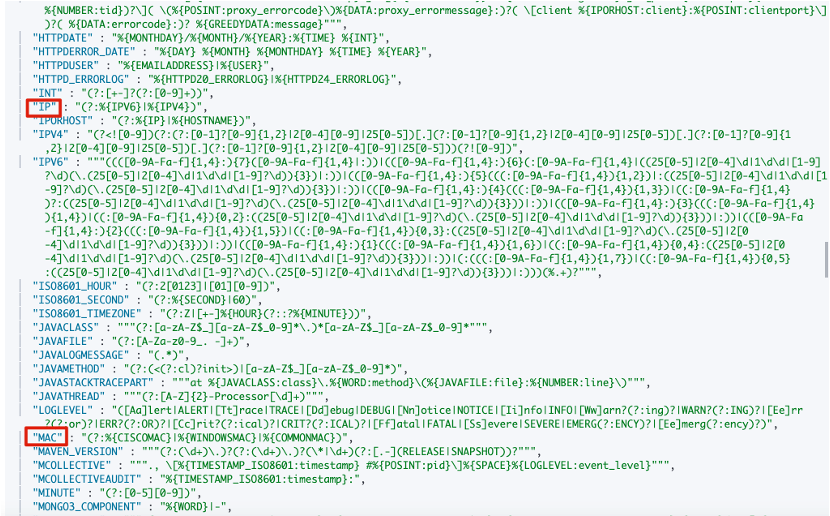
接下来我们尝试使用 grok 处理器解析一条日志。%{<expression>:<field>} 表示将表达式匹配的值赋值到指定的 field 字段中,表达式可以是我们自定义的表达式,也可以是表达式别名;%{<expression>} 表示只匹配不赋值。
55.3.244.1 GET /index.html 15824 0.043"在上面的日志中:
%{IP:client} 匹配 IP 地址,赋值到 client 字段中;%{WORD:method} 匹配数字和字母,赋值到 method 字段中;%{URIPATHPARAM:request} 匹配 URI 路径和参数,赋值到 request 字段中;%{NUMBER:bytes:int} 匹配数字,赋值到 bytes 字段中,并且将字段设置为 int 类型;%{NUMBER:duration:double} 匹配数字,赋值到 duration字段中,并且将字段设置为 double 类型。上面用到的 IP, WORD, URIPATHPARAM, NUMBER 表达式都是 grok 内置的表达式别名,可以直接拿来使用。
POST _ingest/pipeline/_simulate
{
"pipeline": {
"processors": [
{
"grok": {
"field": "message",
"patterns": ["%{IP:client} %{WORD:method} %{URIPATHPARAM:request} %{NUMBER:bytes:int} %{NUMBER:duration:double}"]
}
}
]
},
"docs":[
{
"_source": {
"message": "55.3.244.1 GET /index.html 15824 0.043"
}
}
]
}
# 返回结果
{
"docs" : [
{
"doc" : {
"_index" : "_index",
"_type" : "_doc",
"_id" : "_id",
"_source" : {
"duration" : 0.043,
"request" : "/index.html",
"method" : "GET",
"bytes" : 15824,
"client" : "55.3.244.1",
"message" : "55.3.244.1 GET /index.html 15824 0.043"
},
"_ingest" : {
"timestamp" : "2022-03-01T03:33:57.627169176Z"
}
}
}
]
}除了使用 grok 内置的表达式以外,grok 处理器也允许我们自定义表达式。可以在 pattern_definitions 参数中进行设置,其中键是我们自定义表达式的别名,值是具体的正则表达式。如下所示,我们定义了两个表达式别名:FAVORITE_DOG 使用正则表达式 \w+, 匹配数字和字母,注意这里需要额外使用一个 \ 来进行转义;RGB 可以匹配 RED,GREEN,BLUE 3 种颜色。
POST _ingest/pipeline/_simulate
{
"pipeline": {
"processors": [
{
"grok": {
"field": "message",
"patterns": [
"my %{FAVORITE_DOG:dog} is colored %{RGB:color}"
],
"pattern_definitions": { // 自定义表达式
"FAVORITE_DOG": "\\w+", // 匹配数字和字母
"RGB": "RED|GREEN|BLUE" // 匹配 3 个颜色
}
}
}
]
},
"docs": [
{
"_source": {
"message": "my beagle is colored BLUE"
}
}
]
}
# 返回结果
{
"docs" : [
{
"doc" : {
"_index" : "_index",
"_type" : "_doc",
"_id" : "_id",
"_source" : {
"message" : "my beagle is colored BLUE",
"color" : "BLUE",
"dog" : "beagle"
},
"_ingest" : {
"timestamp" : "2022-03-01T03:34:33.933398405Z"
}
}
}
]
}有时候一种匹配规则可能难以匹配所有的内容,我们可以在正则表达式中通过或的逻辑进行判断,但是这样会使得写出来的表达式难以阅读。这里还有一种更好的方法,在 grok 处理器中,patterns 参数允许填写多个表达式,这样我们的匹配规则看上去就一目了然,处理器会使用最先匹配到的表达式。如下所示,我们设置了 FAVORITE_DOG 和 FAVORITE_CAT 两个表达式都用于解析 pet 字段,如果想要知道是哪个表达式匹配了内容,可以设置参数 "trace_match": true,这样在返回结果的 _grok_match_index 字段中可以看到匹配了哪个表达式,其中 1 表示匹配了第二个表达式。
POST _ingest/pipeline/_simulate
{
"pipeline": {
"description": "parse multiple patterns",
"processors": [
{
"grok": {
"field": "message",
"patterns": [ // patterns 是数组, 可以填写多个表达式
"%{FAVORITE_DOG:pet}",
"%{FAVORITE_CAT:pet}"
],
"pattern_definitions": {
"FAVORITE_DOG": "beagle",
"FAVORITE_CAT": "burmese"
},
"trace_match": true // 显示匹配了哪一个表达式, 第一个从 0 开始
}
}
]
},
"docs": [
{
"_source": {
"message": "I love burmese cats!"
}
}
]
}
# 返回结果
{
"docs" : [
{
"doc" : {
"_index" : "_index",
"_type" : "_doc",
"_id" : "_id",
"_source" : {
"message" : "I love burmese cats!",
"pet" : "burmese"
},
"_ingest" : {
"_grok_match_index" : "1", // 匹配了第 2 个表达式
"timestamp" : "2022-03-01T03:35:05.490483581Z"
}
}
}
]
}在 Kibana 的界面上还提供了 Grok Debugger 方便我们调试 grok 表达式。点击 Management -> Dev Tools -> Grok Gebugger 进入调试界面。

从上图可以看到,调试界面分为以下 4 个部分:
我们将示例中的内容按照上面的说明填写到相应的位置,点击 Simulate,就可以看到解析完成后的结构化数据了。
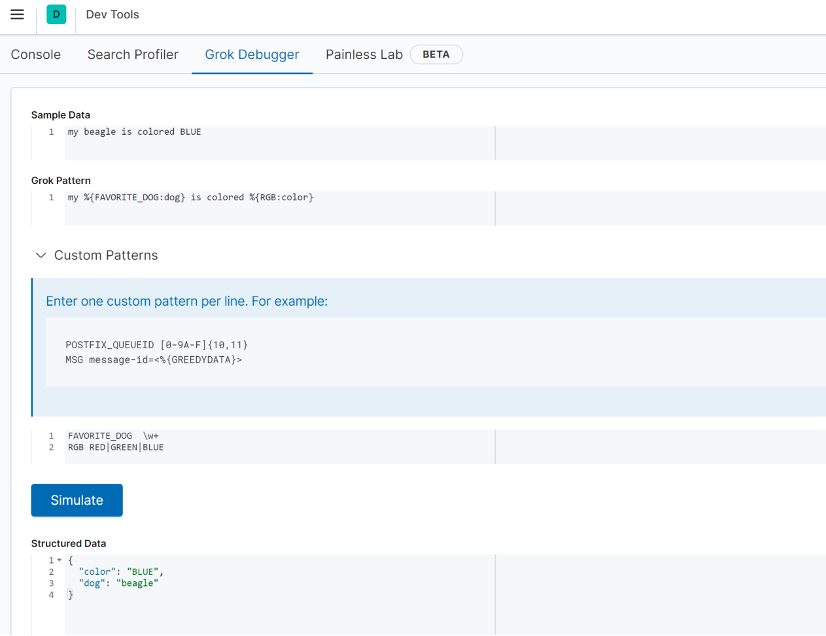
dissect 和 grok 处理器类似,都是用于从单个文本字段中提取结构化字段。与 grok 相比,dissect 最大的优势就是简单和快速,dissect 在解析时不使用正则表达式,这使得 dissect 的语法更加简单,并且执行速度比 grok 更快。当然 grok 也有自己的独到之处,grok 可以同时使用多个 patterns 来对内容来进行匹配,这是 dissect 所不具备的能力。接下来首先介绍一下 dissect 处理器简单的使用方法,如下所示,我们要对一行日志内容进行解析,%{<field>} 表示将匹配到的字符串作为 field 字段的值。
POST _ingest/pipeline/_simulate
{
"pipeline": {
"processors": [
{
"dissect": {
"field": "message",
"pattern": "%{clientip} %{ident} %{auth} [%{@timestamp}] \"%{verb} %{request} HTTP/%{httpversion}\" %{status} %{size}"
}
}
]
},
"docs": [
{
"_source": {
"message": "1.2.3.4 - - [30/Apr/1998:22:00:52 +0000] \"GET /english/venues/cities/images/montpellier/18.gif HTTP/1.0\" 200 3171"
}
}
]
}
# 返回结果
{
"docs" : [
{
"doc" : {
"_index" : "_index",
"_type" : "_doc",
"_id" : "_id",
"_source" : {
"request" : "/english/venues/cities/images/montpellier/18.gif",
"auth" : "-",
"ident" : "-",
"verb" : "GET",
"message" : """1.2.3.4 - - [30/Apr/1998:22:00:52 +0000] "GET /english/venues/cities/images/montpellier/18.gif HTTP/1.0" 200 3171""",
"@timestamp" : "30/Apr/1998:22:00:52 +0000",
"size" : "3171",
"clientip" : "1.2.3.4",
"httpversion" : "1.0",
"status" : "200"
},
"_ingest" : {
"timestamp" : "2022-03-01T06:37:23.791866312Z"
}
}
}
]
}在 dissect 中可以使用修饰符改变默认的匹配规则,例如可以指定 dissect 忽略某些字段、拼接多个字符等等。dissect 的修饰符说明如下表所示。
修饰符 | 用途 | 位置 | 示例 |
|---|---|---|---|
-> | 跳过 -> 右边重复的字符 | 最右边 | %{keyname1->} |
将多个结果附加到一起作为输出 | 左边 < 标签: 暂无标签
请 登录 后回复
|